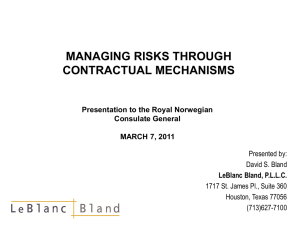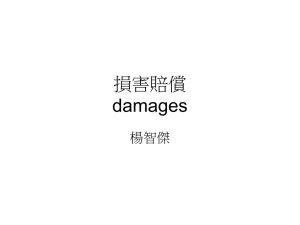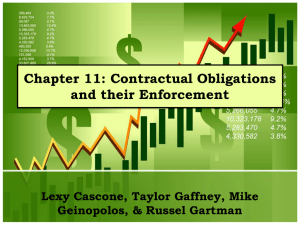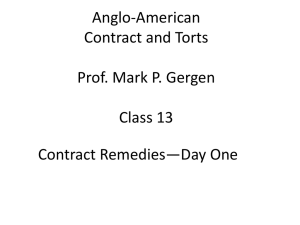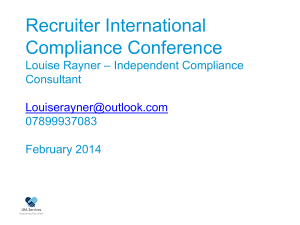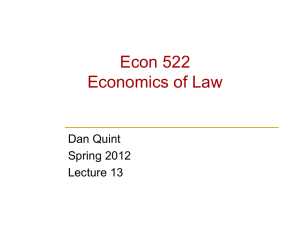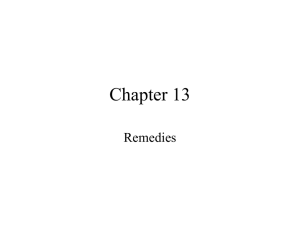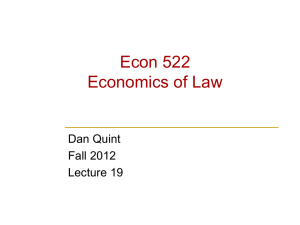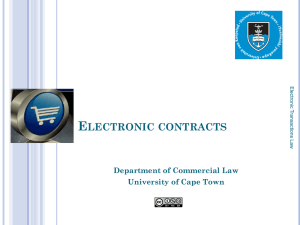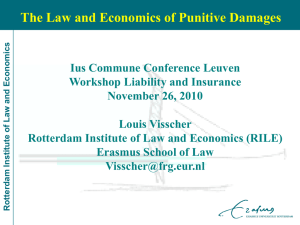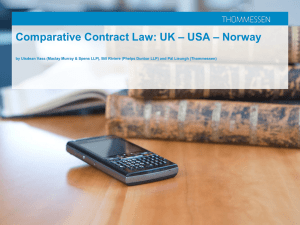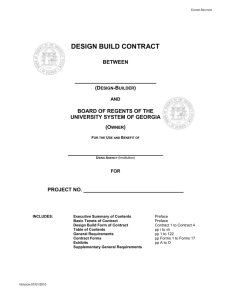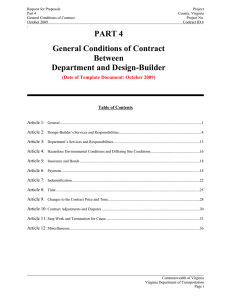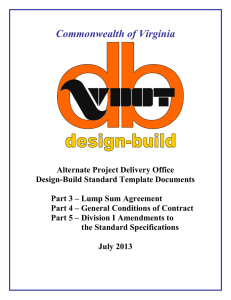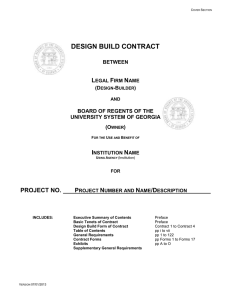Design-Build Cases 2011 Year in Review - DBIA Mid
advertisement
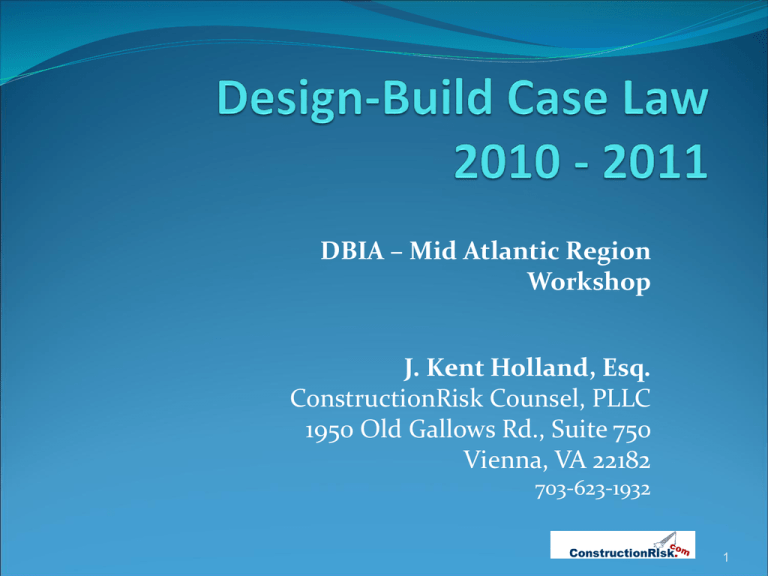
DBIA – Mid Atlantic Region Workshop J. Kent Holland, Esq. ConstructionRisk Counsel, PLLC 1950 Old Gallows Rd., Suite 750 Vienna, VA 22182 703-623-1932 1 Documenting the Agreement Between the Parties 2 Battle of the Forms: What Terms Govern? • On City of Savannah parking garage project, the design- builder and its engineering subconsultant litigated over what contract terms and conditions applied to the contract between them. • Engineer’s Letter Proposal contained scope of services, and a terms and conditions sheet. • Purchase Order (PO) by Kr contained different terms and conditions (but also referenced the Engineer’s proposal). • Court found PO was the final form (counteroffer) – and engineer did not object to it, but instead began its services. – Trial necessitated by ambiguity and need to determine intent. Batson-Cook Company v. TRC Worldwide Eng., (2011) 3 Licensing Statutes Incorrectly Asserted as Defense Against Paying Design-Builder • Where Contractor proposed to design-build hospital expansion, it performed numerous services before hospital decided not to go forward – and refused to pay for: – Partial design; – Preparation of cost estimates to used in GMP; • Hospital proceeded with design-bid-build, and gave contractor’s design documents to a design professional to use. • In defending against contractor suit, Hospital alleged Kr: – violated law by not having contractor’s license before performance of construction management. – Violated law by performing A/E services without license 4 Court granted Contractor’s SJ motion because: Kr did not construct or manage construction prior to receiving license. Kr’s proposal to perform initial design and prepare cost estimate to derive GMP for Hospital was not a “bid” in violation of law A/E licensing statute didn’t contain penalty provision rendering contract for professional services void. Kr not prevented by statute from recovering under quantum meruit and promissory estoppel Since no written contract was executed – Kr needed this remedy. Drew County v. Murray Company, 2011 WL 1533434 (E.D. Ark) 5 Letters of Intent: When are They Enforceable? Court finds developer may be entitled to recover for Owner’s breach of contract on a Letter of Intent (LOI) agreement where the Developer expended time and cost in reliance on the LOI but the deal ultimately fell apart before final contract was executed for design and construction of a new medical office building (MOB II). LOI stated: “Your acceptance of this letter will constitute such authorization [to initiate development] and serve as the binding agreement between our two parties until a formal development agreement is executed.” 6 • LOI stated Developer would: – Own an interest in building; – Design and build it; – Receive fees for specified services; – Agree to ground lease and tenant lease terms; – Adhere to a construction budget. • No remedies or liability specified in LOI if project aborted or given by owner to a different developer. • After LOI was signed, Owner decided it wanted Developer to buy the old MOB from Owner. – Parties couldn’t agree to purchase price. – Without purchase of MOB I, Owner said MOB II could not go forward. 7 Developer sued Owner for breach of contract. Owner moved for SJ, arguing: There were unaccepted offers and counteroffers; There was no enforceable contract; and Damage claims barred by Statute of Frauds. Court found the LOI showed the parties intended to be bound by its terms “at the moment of acceptance, before the negotiation of more formalized agreements.” It may have been intended as an interim agreement, but it was intended to be binding nonetheless. SJ denied and matter goes to jury for decision on merits. Erdman v. USMD of Arlington (2011 WL 1356920 (N.D. Tex, 2011) 8 Differing Site Conditions Claims: Same Rules Apply on Design-Build Projects as Other Types of Projects 9 DSC Claim Denied for Suspected UXOs Design-Builder that was awarded contract to remediate landfill on military base in Italy claimed entitlement to equitable adjustment for DSC based on: Suspicion it had that UXOs might be present Delay to its work due to Govt not issuing a “War Bombs Reclamation Certification.” ASBCA denied appeal from Contracting Officer’s rejection of DSC claim because: No UXO was actually found at the site; Kr did not prove that “certification” was legally required or that Govt had duty to evaluate risk CEMES, ASBCA No. 56253, 11-1 BCA P 34640 (Dec. 2010) 10 Kr Entitled to Recover on DSC Based on Conditions differing from Soil Reports On underground parking garage project, the engineer subcontractor of Design-Builder incurred costs redesigning foundations due to soft clay differing from soil reports. Owner denied Kr claim, asserting: Lack of written notice; Failure to meet various procedural requirements such as affidavits that subcontractors had been fully paid; Because soil reports showed clay, there could be no DSC based on clay Kr prevailed (over $15M plus $2M attys fees) 11 Court’s holding: Notice was sufficient: Not required to be written DSC could be found since type and amount of clay could be deemed different from what was shown in the soil reports Jury could find bad faith by City because City “rejected Batson–Cook's materially different conditions claim, simply because the [soil] reports had always indicated the presence of clay,” and ignored the provisions for DSC claims for site conditions that “differed materially from the conditions indicated in the contract documents or from conditions ordinarily found to exist….” Quantum meruit claim also allowed for matters beyond the contract. City of Savannah v Batson-Cook, 714 S.E.2d 242 (Ga. 2011) 12 Contract Language is Important: Ignore it at your own peril! 13 Indemnification Clause Required Indemnity for “all” damages. Black & Veatch (“B & V”) to EPC a power plant. Subcontracted combustion turbine installation. “Foreign object damage” to a number of the compressor blades after start up. (Cutoff bolt, a welding rod, and a halfmoon shaped cut metal plate were found). B&V paid damages to owner and sued sub under indemnity clause for $1.5 million in direct costs to repair the damage, and another $2.1 million due to delays caused by the damage. Black & Veatch Construction, Inc. v. JH Kelly, LLC, 2011 WL 1706223 (U.S. District Court, D. Oregon, 2011 14 Summary judgment for B&V, finding: Indemnity language was broad enough to require indemnity for “any and all” damages, including delay damages, and the waiver of consequential damages clause was inapplicable because that clause expressly excepted its applicability to obligations under the indemnity clause. No subcontractor right to recover contribution from Mitsubishi, the manufacturer, because not independently responsible by contract or tort for the damages. 15 Liquidated Damages Enforceable Even Where Far Exceeding Actual Damages Miller Act claim filed against Dick Corp. by U.S. on behalf of subcontractor on design-build project at Pensacola Naval Air Station. Dick made counter-claim against sub, arguing it was entitled to withhold payment, and anything owed was more than offset by Liquidated Damages Sub owed Contractor. Sub argued LD provision unenforceable because: Navy didn’t assess LDs against Contractor; It caused no delay to trigger the LDs LDs are unconscionable penalty – far exceeding actual damages sustained. U.S. v. Dick Corp., 2010 WL 4666747 (2010, N.D. Fla.) 16 Court concluded although LDs are “far in excess” of the actual damages, it was not possible to ascertain when the parties entered into the contract what the actual damages would be. Even if Dick could calculate part of its potential actual damages when entering contract, there were additional unascertainable factors. The LDs were not “grossly disproportionate to damages that might reasonably be expected to follow… from delays.” 17 Design-Builder Failed to Prove Liquidated Damages Amount was Arbitrary Coast Guard assessed LDs against design-builder that was late in performance and was terminated for default. Contractor filed suit (and SJ motion) and argued the $ amount set for the LDs was unreasonable based on what was used on other projects and based on certain components such as Govt personnel and administrative costs being included. Court denied SJ because: Kr did not prove that rate was unreasonable at time it was set by CO based on info available to the CO. Govt personnel and admin costs can be included in rate. K-Con Building Systems, Inc. v. U.S., 97 Fed.Cl. 41 (2011) 18 Contractor Forfeits Recovery for Extra Work Performed without Approved Change Order Design Builder had fixed-price contract to upgrade HVAC in college dorms. Performed significant extra work due to unforeseen problems with existing system – with approval of CM. University refused to pay anything other than original contract price because Change Order was never executed by Purchasing Dept. Court granted SJ for University, finding contractor did work without first getting approved change order No recovery for unjust enrichment or quantum meruit allowed. Mallory & Evans Contractors and Engrs v. Tuskegeee U., 2010 WL 5137580 (M.D. Ala., Dec 2010) 19 Comply with Plans & Specifications (Even if you wrote them) 20 Expert Testimony Supported Finding Rework Required was Due to Failure to Meet Plans and Specs Expert testified inaccurate rebar spacing and variable concrete covers weakened walls of animal feed plant, requiring tear out and replacement of 4,440 ft of bin wall ($2 M). Design-Builder filed mechanics lien and filed suit for balance due under contract. Owner counter sued for breach of contract and warranty. Expert ‘s opinion based on survey results from “small segment” and testimony of employees. Held: Testimony satisfactory. Absolute certainty not required. Younglove Constr. V. PSD Develop., 2011 WL 1004916 (N.D. OH, 2011) 21 Design vs. Performance Specifications If Owner includes design details in its bridging documents, these will be binding on the Design-Builder. When responding to D/B solicitation, need to understand which aspects of concept documents developed by owner are discretionary and which are not. Electrical specs in solicitation described conduit size and characteristics as well as details of supports for the raceways. Dillingham Constr. v. U.S., 33 Fed.Cl. 495 (1995). 22 Design v. Performance Specifications (2) Dillingham’s electrical sub wanted to use metal clad cable instead of raceways. Owner rejected this proposal. When sub installed supports differing from those specified, the owner required them to be removed and replaced. The sub submitted a $600,000 claim for extra costs to comply with these requirements. Argued specs were “performance” based -- providing “general guidelines” giving sub “wide latitude” to interpret. Court found specs were “design” specs that gave sub no flexibility to deviate. 23 Design v. Performance Specifications (3) Court rejected sub’s argument and noted that the contract specifically required sub to furnish a design that complied with the electrical specifications. Court found the specifications to be “design” specs that gave sub no flexibility to deviate. 24 Indemnification and Defense Obligations Can Be Costly 25 Assignee of Contract Indemnification Rights under a Design-Build Contract Stands in Shoes of Indemnitee and is Entitled to Recover Defense Costs Kr entered into a contract to design and construct a soda ash processing plant for Owner. Kr agreed to provide Owner defense and indemnity against losses arising out of negligent performance of its work. Owner later assigned property and contract to new Owner that as Assignee paid defense costs original Owner incurred in defending against a $6.7 M wrongful death action by heirs of laborer that was killed while working at the plant. Searles Valley Minerals Operations, Inc. v. Ralph Parson Service Company, 191 Cal.App. 4th 1394 (Cal. 2011). 26 Held: Assignee of contract indemnification rights stands in the shoes of the indemnitee. Cal. Civ. Code 2778 requires indemnitor to also defend the indemnitee unless affirmatively stated in the contract to the contrary. The fact that only the Owner and a subcontractor to the design-builder were found negligent did not prevent the design-builder from owing the duty to defend. $800,000 attorneys fees and costs were at issue. 27 Indemnity, LoL & Insurance Can be Tied Together. Claim Release Enforced. EPC contract for refinery required Contractor CGL policy, and limited Kr liability to an amount based on insurance proceeds. Release & waiver provisions stated Valero would “release, defend, indemnify, and hold harmless” the contractors to extent insurance did not cover loss. Contract executed after the work on facility was complete. Unrelated explosions (due to different Kr’s products) occurred 2 and 3 years after contract execution. National Union Fire Ins. V. John Zink Co., 2010 WL 4523760 (Tex. 2010) 28 Valero and Insurers argued that because LoL/waiver/release was executed PRIOR to the explosions, it did not apply to claims for damages from the later explosions. Held: Since the alleged negligence of contractors was on work performed prior to the waiver/release being signed, damages arising out of the negligent work was released even though explosions and damages had not yet occurred. What matters is when the negligence occurred – not when the damages materialized. 29 In enforcing the release provision, the court explained: “Valero and Kellogg are sophisticated entities, replete with learned counsel…. They negotiated their working relationship over the course of almost three years with Kellogg submitting several proposals for Valero’s review…. Valero, having bargaining power equal to Kellogg’s, agreed to the exculpatory clause in this contract. Valero possessed resources necessary to ascertain and understand the rights it held…. Valero, of its own accord, negotiated those rights away.” 30 Attorney’s Fees Awarded as Part of Indemnification Obligation Indemnification clause: “The Testing and Inspection Firm further agrees to indemnify and hold Wal–Mart free and harmless from any claim, demand, loss, damage, or injury (including Attorney's fees) caused by any negligent act or omission by the Testing and Inspection Firm, its agents, servants, or employees.” Wal-Mart made 1st party claim against engineer and Kr for damages to building and parking lot. Engineer 10% liable for damages to building only ($48,600). Ct. awarded Wal-Mart $810,000 attys fees against engineer. Reversed on appeal. Wal-Mart v. Qore, 647 F.3d 237 (5th Cir., 2011) (Not a design-build case) 31 Held: (1) Indemnification is not limited to damages arising out of third party claims against the indemnitee. First party claims are covered too unless clearly stated otherwise. (2) Where attys fees would not be recovered under common law or statutory law, the contractual indemnification clause may require them anyway. (3) Wal–Mart's recovery should have been limited to fees incurred in proving engineer’s liability on the building repair claim. Proportionate share only. Lesson: Draft indemnity clause to apply only to third party claims. Beware that contractual liability exclusion in a/e policy excludes coverage for attorneys fees awarded under indemnification clause. 32 Questions? Contact: Kent Holland Kent@ConstructionRisk.com For Case Notes and Articles on design-build decisions and other case law, visit: www.ConstructionRisk.com for research or for free newsletter: “ConstructionRisk.com Report” 33
